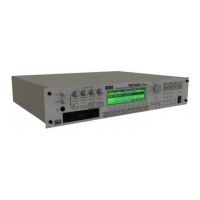232
Memory protected
Multisample L and R are identical
N
No data
No medium
No space available on medium
Not enough memory
Not enough memory to load
Not enough multi locations available
Not enough multi memory
Not enough multisample memory
Not enough pattern locations available
Not enough relative parameter memory
Not enough sample memory
Not enough sample/multisample locations available
Action: • Edit the .SNG file
In Sequencer mode of the TRITON, edit the
song data so that it will fit in the Demo Song
area, create the .SNG file, and use the TRITON-
Rack’s Disk mode to execute “Load to Demo
Song.”
• Reduce the number of songs in the .SNG file
In Disk mode, load the .SNG file with its track
event data (☞p.126, 128). Then execute “Delete
Multi” in Multi mode so that the data will fit
into the Demo Song area, and execute the
DEMO/SNG page command “Make Demo
Song.” For details on the size of the Demo
Song area, refer to p.132.
Meaning: The internal program, combination, multi, drum
kit, or user arpeggio pattern is protected.
Action: In Global mode, turn off write-protect, and exe-
cute the write or load operation once again.
Meaning: Since the destination (save location) L and R mul-
tisample numbers are the same, the editing opera-
tion could not be executed.
Action: Select a different multisample number for the L
and R of the destination (save location).
Meaning: When loading a Standard MIDI File, the file con-
tained no events.
Meaning: When you executed Disk mode “Load to Demo
Song” or DEMO/SNG page “Make Demo Song,”
event data did not exist in the track.
Action: Load a .SNG file that contains track event data.
Meaning: When you executed “Export Samples as AIFF/
WAVE” for Samples in One Multisample, there
were no samples.
Action: Create sample data.
Meaning: When executing a command in Disk mode, no
media (floppy disk etc.) was inserted in the drive.
Action: Insert media such as a floppy disk, or mount the
drive.
Meaning: When you attempted to save a file or create a
director, the medium (floppy disk etc.) contained
no free space.
Action: Either delete an existing file, or exchange the
medium with one that has sufficient free space.
Meaning: When starting realtime recording in Multi mode,
the minimum amount of free memory (such as
memory for the BAR events up to the recording
start location) could not be allocated.
Action: Delete other multi data etc. to increase the amount
of free memory.
Meaning: When executing “Save Exclusive” in Disk mode,
there was no remaining sequence memory. Alter-
natively, when executing “Load Exclusive,” suffi-
cient free sequence memory could not be
allocated.
Action: Delete multi data. (If necessary, save the multi
data before deleting it.)
Meaning: When you attempted to load a .SNG file in Disk
mode, there was insufficient free memory.
Action: Delete other multi data etc. to increase the amount
of free memory.
Meaning: When loading a .SNG file as “Append,” you
attempted to load a larger number of multis than
could be added.
Action: In Multi mode execute “Delete Multi” to increase
the number of multis that can be used. Then
reload the data.
Meaning: When executing the Sampling mode function
Time Slice “Save,” the total data for all multi has
used up the entire sequence data memory, so sav-
ing is not possible.
Action: Delete other multi data etc. to increase the free
memory.
Meaning: There is insufficient multisample memory. (The
number of multisamples would exceed the maxi-
mum of 1,000.)
Action: Delete multisamples to increase the amount of
free memory.
Meaning: When loading an SMF file, you exceeded the
remaining number of multi user patterns that
could be added.
Action: In Multi mode execute “Delete Pattern” to
increase the number of user patterns that can be
used. Then reload the data.
Meaning: There is insufficient memory for relative parame-
ters. (The number of samples in the multisamples
would exceed the maximum of 4,000.)
Action: Delete multisamples or indices of multisamples to
increase the amount of free memory.
Meaning: There is insufficient sample memory (for sample
parameters or sample waveform data).
Action: Delete samples to increase the amount of free
memory.
Meaning: The data you attempted to load would exceed the
maximum number of multisamples or samples.
Action: In Sampling mode, execute “Delete Multisample”
or “Delete Sample” to free a sufficient number,
and reload the data.

